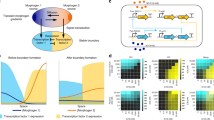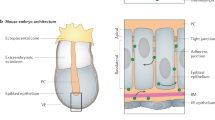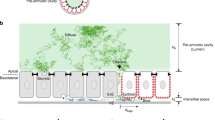Abstract
Morphogens are molecules that specify cell fate in a concentration-dependent manner. A classic example is the Bicoid (BCD) protein, for which the prevailing model is that translation of bcd mRNA occurs from a point source at the anterior pole of the Drosophila melanogaster embryo followed by diffusion to produce a protein gradient. This model has been challenged by experiments showing that the diffusion rate of BCD is too slow to establish the protein gradient. The work described in a recent paper has solved this conundrum by demonstrating that a bcd mRNA gradient prefigures the BCD protein gradient.
This is a preview of subscription content, access via your institution
Access options
Subscribe to this journal
Receive 12 print issues and online access
$189.00 per year
only $15.75 per issue
Buy this article
- Purchase on Springer Link
- Instant access to full article PDF
Prices may be subject to local taxes which are calculated during checkout



Similar content being viewed by others
References
Turing, A. M. The chemical basis of morphogenesis. Philos. Trans. Roy. Soc. (Lond) 237, 37–72 (1952).
Gierer, A. & Meinhardt, H. A theory of biological pattern formation. Kybernetik 12, 30–39 (1972).
Wolpert, L. Positional information and pattern formation. Curr. Top. Dev. Biol. 6, 183–224 (1971).
Zecca, M., Basler, K. & Struhl, G. Direct and long-range action of a wingless morphogen gradient. Cell 87, 833–844 (1996).
Nellen, D., Burke, R., Struhl, G. & Basler, K. Direct and long-range action of a DPP morphogen gradient. Cell 85, 357–368 (1996).
Lawrence, P. A., Casal, J. & Struhl, G. The hedgehog morphogen and gradients of cell affinity in the abdomen of Drosophila. Development 126, 2441–2449 (1999).
Heemskerk, J. & DiNardo, S. Drosophila hedgehog acts as a morphogen in cellular patterning. Cell 76, 449–460 (1994).
Frohnhöfer, H. G. & Nüsslein-Volhard, C. Organization of anterior pattern in the Drosophila embryo by the maternal gene bicoid. Nature 324, 120–125 (1986).
Driever, W. & Nüsslein-Volhard, C. A gradient of bicoid protein in Drosophila embryos. Cell 54, 83–93 (1988).
Struhl, G., Struhl, K. & Macdonald, P. M. The gradient morphogen bicoid is a concentration-dependent transcriptional activator. Cell 57, 1259–1273 (1989).
Driever, W., Siegel, V. & Nüsslein-Volhard, C. Autonomous determination of anterior structures in the early Drosophila embryo by the bicoid morphogen. Development 109, 811–820 (1990).
Frigerio, G., Burri, M., Bopp, D., Baumgartner, S. & Noll, M. Structure of the segmentation gene paired and the Drosophila PRD gene set as part of a gene network. Cell 47, 735–746 (1986).
Kornberg, T. B. & Guha, A. Understanding morphogen gradients: a problem of dispersion and containment. Curr. Opin. Genet. Dev. 17, 264–271 (2007).
Gregor, T., Tank, D. W., Wieschaus, E. F. & Bialek, W. Probing the limits to positional information. Cell 130, 153–164 (2007).
Gregor, T., Wieschaus, E. F., McGregor, A. P., Bialek, W. & Tank, D. W. Stability and nuclear dynamics of the bicoid morphogen gradient. Cell 130, 141–152 (2007).
Spirov, A. et al. Formation of the bicoid morphogen gradient: an mRNA gradient dictates the protein gradient. Development 136, 605–614 (2009).
Driever, W. & Nüsslein-Volhard, C. The bicoid protein determines position in the Drosophila embryo in a concentration-dependent manner. Cell 54, 95–104 (1988).
Driever, W. & Nüsslein-Volhard, C. The bicoid protein is a positive regulator of hunchback transcription in the early Drosophila embryo. Nature 337, 138–143 (1989).
Burz, D. S., Rivera-Pomar, R., Jackle, H. & Hanes, S. D. Cooperative DNA-binding by Bicoid provides a mechanism for threshold-dependent gene activation in the Drosophila embryo. EMBO J. 17, 5998–6009 (1998).
Driever, W., Thoma, G. & Nusslein-Volhard, C. Determination of spatial domains of zygotic gene expression in the Drosophila embryo by the affinity of binding sites for the bicoid morphogen. Nature 340, 363–367 (1989).
Rivera-Pomar, R., Niessing, D., Schmidt-Ott, U., Gehring, W. J. & Jackle, H. RNA binding and translational suppression by bicoid. Nature 379, 746–749 (1996).
Dubnau, J. & Struhl, G. RNA recognition and translational regulation by a homeodomain protein. Nature 379, 694–699 (1996).
Weil, T. T., Parton, R., Davis, I. & Gavis, E. R. Changes in bicoid mRNA anchoring highlight conserved mechanisms during the oocyte-to-embryo transition. Curr. Biol. 18, 1055–1061 (2008).
Ferrandon, D., Elphick, L., Nüsslein-Volhard, C. & St Johnston, D. Staufen protein associates with the 3'UTR of bicoid mRNA to form particles that move in a microtubule-dependent manner. Cell 79, 1221–1232 (1994).
Zimyanin, V. L. et al. In vivo imaging of oskar mRNA transport reveals the mechanism of posterior localization. Cell 134, 843–853 (2008).
Mlodzik, M. & Gehring, W. J. Expression of the caudal gene in the germ line of Drosophila: formation of an RNA and protein gradient during early embryogenesis. Cell 48, 465–478 (1987).
Macdonald, P. M. & Struhl, G. A molecular gradient in early Drosophila embryos and its role in specifying the body pattern. Nature 324, 537–545 (1986).
Cho, P. F. et al. A new paradigm for translational control: inhibition via 5′-3′ mRNA tethering by Bicoid and the eIF4E cognate 4EHP. Cell 121, 411–423 (2005).
Schulz, C., Schroder, R., Hausdorf, B., Wolff, C. & Tautz, D. A caudal homologue in the short germ band beetle Tribolium shows similarities to both the Drosophila and the vertebrate caudal expression patterns. Dev. Genes Evol. 208, 283–289 (1998).
Olesnicky, E. C. et al. A caudal mRNA gradient controls posterior development in the wasp Nasonia. Development 133, 3973–3982 (2006).
Bucher, G., Farzana, L., Brown, S. J. & Klingler, M. Anterior localization of maternal mRNAs in a short germ insect lacking bicoid. Evol. Dev. 7, 142–149 (2005).
Lynch, J. A., Brent, A. E., Leaf, D. S., Pultz, M. A. & Desplan, C. Localized maternal orthodenticle patterns anterior and posterior in the long germ wasp Nasonia. Nature 439, 728–732 (2006).
Dubrulle, J. & Pourquie, O. fgf8 mRNA decay establishes a gradient that couples axial elongation to patterning in the vertebrate embryo. Nature 427, 419–422 (2004).
Lecuyer, E. et al. Global analysis of mRNA localization reveals a prominent role in organizing cellular architecture and function. Cell 131, 174–187 (2007).
De Renzis, S., Elemento, O., Tavazoie, S. & Wieschaus, E. F. Unmasking activation of the zygotic genome using chromosomal deletions in the Drosophila embryo. PLoS Biol. 5, e117 (2007).
Tadros, W. et al. SMAUG is a major regulator of maternal mRNA destabilization in Drosophila and its translation is activated by the PAN GU kinase. Dev. Cell 12, 143–155 (2007).
Bashirullah, A. et al. Joint action of two RNA degradation pathways controls the timing of maternal transcript elimination at the midblastula transition in Drosophila melanogaster. EMBO J. 18, 2610–2620 (1999).
Acknowledgements
Sincere thanks to M. Noll and S. Baumgartner for providing the images used in figure 2. H.D.L.'s research on post-transcriptional regulation in D. melanogaster is supported by the Canadian Institutes for Health Research in the form of an operating grant (MOP-14409) and a team grant (CIHR Team in mRNP Systems Biology; CTP-79838).
Author information
Authors and Affiliations
Related links
Rights and permissions
About this article
Cite this article
Lipshitz, H. Follow the mRNA: a new model for Bicoid gradient formation. Nat Rev Mol Cell Biol 10, 509–512 (2009). https://doi.org/10.1038/nrm2730
Issue Date:
DOI: https://doi.org/10.1038/nrm2730
This article is cited by
-
Seeing is believing: the Bicoid protein reveals its path
Hereditas (2018)
-
Drosophila embryo syncytial blastoderm cellular architecture and morphogen gradient dynamics: Is there a correlation?
Frontiers in Biology (2012)



